How to Grow Snake Fruit
- April 3, 2024
- 0 comment
Snake Fruit, commonly known as Salak, is a tropical fruit known for its reddish-brown scaly skin and sweet, tangy flavor. Native to Indonesia, it grows on a species of palm tree and is gaining popularity in tropical and subtropical regions worldwide. This article provides a comprehensive guide on how to cultivate Snake Fruit for both commercial growers and hobbyists.

Snake Fruit Health Benefits
| Benefit | Description |
|---|---|
| Nutritional Value | High in carbohydrates, dietary fiber, and vitamins, especially vitamin C. Contains essential nutrients such as potassium, calcium, and iron. |
| Antioxidant Properties | Contains antioxidants like beta-carotene and polyphenols, which help combat oxidative stress and may reduce the risk of chronic diseases. |
| Digestive Health | The dietary fiber in Snake Fruit aids in digestion and prevents constipation. It can also help maintain a healthy gut flora. |
| Heart Health | The potassium content helps regulate blood pressure, thus promoting heart health. |
| Eye Health | Beta-carotene, a form of Vitamin A, is beneficial for eye health and can prevent vision-related issues. |
| Immune Boosting | High Vitamin C content enhances the immune system, helping the body resist various infections and ailments. |
| Weight Management | Low in fat and high in dietary fiber, making it an excellent snack for weight management and satiety. |
| Skin Health | Antioxidants and vitamins in Snake Fruit can contribute to healthier skin, protecting against premature aging and improving skin texture. |
| Anti-Diabetic Potential | Some studies suggest that the fruit could help in managing blood sugar levels, although more research is needed in this area. |
| Energy Booster | Rich in natural sugars and carbohydrates, providing a quick energy boost. |
List on How To Grow Snake Fruit
Understanding Salacca zalacca
Botanical Characteristics
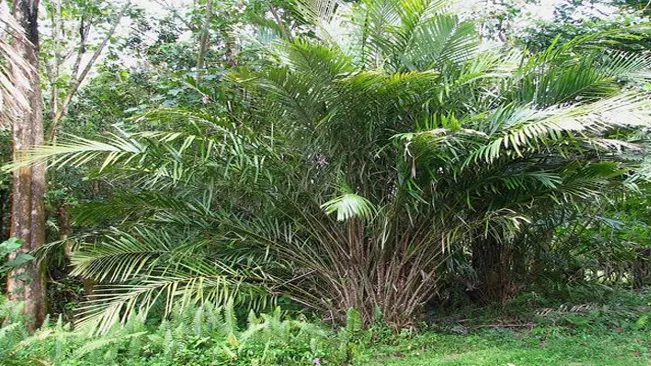
- Growth Habit: Salacca zalacca grows as a clumping palm, often with multiple stems emanating from a single base. These stems are densely covered with sharp spines, making the plant quite formidable.
- Leaves: The leaves are large, pinnate, and also spiny, creating a lush, albeit prickly, canopy.
- Fruit Clusters: The fruit grows in clusters at the base of the palm. Each fruit is small, roughly the size of a fig, with a distinctive scaly skin resembling that of a reptile, hence the name “Snake Fruit.”
Unique Attributes
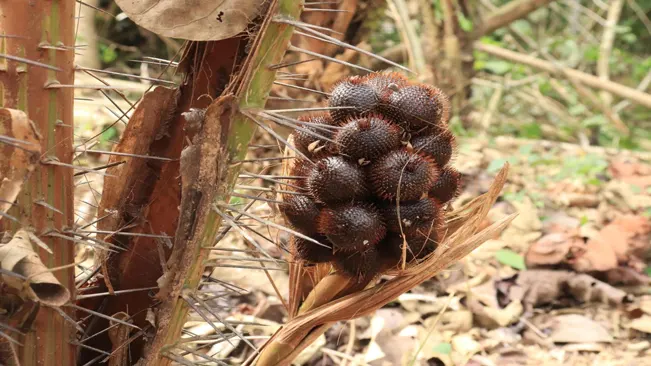
- Flowering and Fruiting: Unlike many other fruit trees, Salacca zalacca does not have a distinct flowering or fruiting season. The palm can produce fruit sporadically throughout the year, depending on the local climate and conditions.
- Growth Rate: It is a relatively slow-growing palm, especially when young or when grown from seed.
Climate and Soil Requirements

Climate Adaptation
- Humidity and Temperature: The plant thrives in high humidity, which mirrors its native tropical environment. It’s also heat-tolerant, making it well-suited to areas with warm temperatures year-round.
- Sunlight: While it can tolerate some direct sunlight, Snake Fruit often does better in partial shade, especially in hotter climates. This mimics the understory conditions of its natural habitat.
Soil Preferences
- Texture and Drainage: The palm prefers loamy soil that provides good drainage. While it needs consistent moisture, it is vulnerable to root rot in waterlogged conditions.
- Soil Fertility: Rich in organic matter, the soil should be able to retain enough moisture to support the plant’s needs without becoming soggy.
- pH Level: Slightly acidic to neutral pH levels are ideal, although the plant shows a reasonable tolerance for slight variations in soil pH.
Planting and Propagation
Propagation Methods
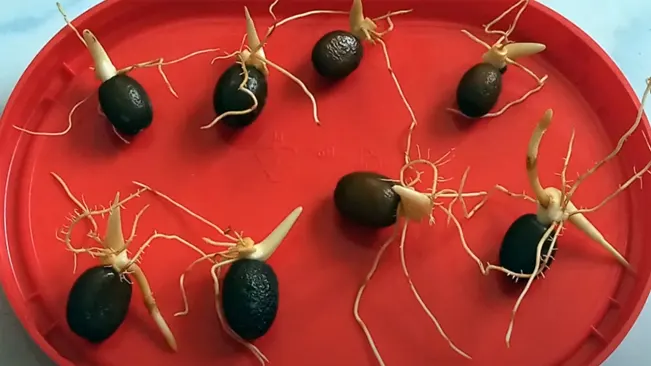
From Seeds
- Preparation: After obtaining Snake Fruit seeds, it’s essential to clean them thoroughly to remove any fruit residue.
- Sowing: Plant the cleaned seeds in a pot or directly in the ground, using well-draining soil. A mix rich in organic matter is beneficial.
- Germination Environment: Ensure the environment is warm and humid, as these conditions encourage germination. Keeping the soil consistently moist but not waterlogged is crucial.
- Germination Time: Patience is required as Snake Fruit seeds can take several weeks, and sometimes even months, to germinate. Consistent warmth and humidity can help speed up this process.
From Suckers
- Collection: Suckers are young shoots that emerge from the base of the parent plant. Select healthy suckers that have their own roots.
- Separation: Carefully detach the suckers from the parent plant, making sure to keep a good amount of roots intact.
- Planting Suckers: Plant these suckers in a similar soil mix as used for seeds, ensuring that the soil is fertile and well-draining.
Planting Process
Spacing
- Importance of Spacing: Proper spacing is crucial for adequate growth. Snake Fruit plants can spread wide and require sufficient space for their roots and leaves.
- Recommended Spacing: Planting the trees about 5 to 6 meters apart is ideal. This spacing allows for proper air circulation and sunlight penetration, reducing the risk of diseases.
Planting Depth
- Seed Depth: When planting seeds, bury them at a depth approximately twice the diameter of the seed.
- Sucker Depth: For suckers, plant them at the same depth they were growing previously. This ensures that the plant’s root system is adequately covered but not too deep to hinder growth.
Care and Maintenance
Watering
- Frequency and Amount: The frequency of watering will depend on the climate and soil type. In hotter climates, more frequent watering may be necessary. The goal is to keep the soil moist but not soggy.
- Monitoring Soil Moisture: Check the soil moisture regularly by feeling the soil a few inches below the surface. If it feels dry, it’s time to water.
- Watering Technique: Use a drip irrigation system or water at the base of the plant to avoid wetting the leaves, which can lead to fungal diseases.
Fertilizing
- Type of Fertilizer: A balanced fertilizer (like an N-P-K ratio of 10-10-10) is ideal. The fertilizer should be rich in potassium and nitrogen to support leaf and fruit growth.
- Application Frequency: Apply the fertilizer according to the manufacturer’s instructions, typically every few months during the growing season.
- Method of Application: Spread the fertilizer evenly around the base of the tree, away from the trunk, and water it in thoroughly.
Pruning
- Removing Spines and Fronds: Use protective gloves and tools to carefully remove spines and old fronds. This not only facilitates easier harvesting but also improves the tree’s appearance and health.
- Shaping the Tree: Regular pruning can help shape the tree and improve air circulation, which is vital for reducing disease risk.
Pest and Disease Control
- Common Pests: Mites and scale insects are frequent culprits. Regularly inspect the tree for signs of infestation. Organic options like neem oil can be effective, as well as chemical pesticides when necessary.
- Disease Prevention: Fungal diseases are a concern. Ensure good air circulation around the tree, and avoid overwatering which can create damp conditions conducive to fungal growth.
- Regular Monitoring: Regularly check your Snake Fruit tree for any signs of pest or disease problems. Early detection and treatment are key to managing these issues.
Harvesting
Maturity Indicators
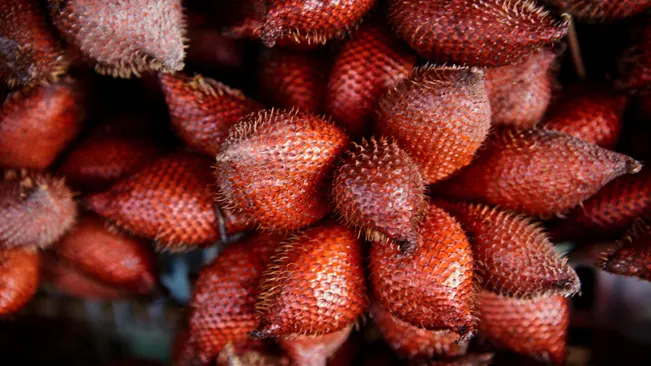
- Color Change: As the fruit ripens, the skin transforms from green to a deep reddish-brown. This color change is a primary indicator of maturity.
- Scale Opening: Another sign of ripeness is the slight opening of the scales covering the fruit. It indicates that the fruit is ready for consumption, revealing the edible part inside.
- Texture and Firmness: The fruit becomes less firm to the touch when it is ripe. However, it should not be overly soft as this may indicate overripeness.
- Observing the Surrounding Environment: Sometimes, observing the natural flora and fauna can provide hints. For instance, increased interest from birds or small animals can indicate ripeness.
Harvest Technique
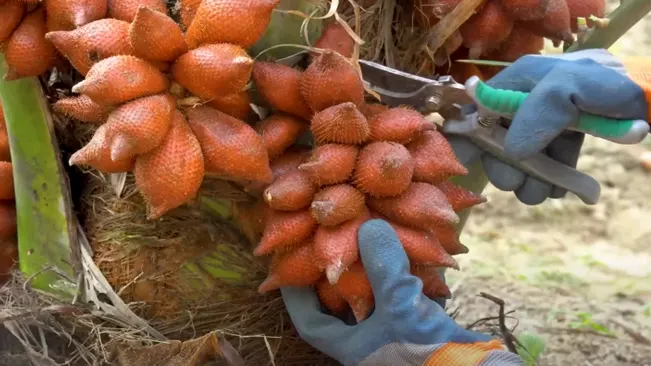
- Safety First: The tree has spiny stems and the fruit itself has a prickly outer layer. It’s essential to wear gloves and long sleeves to protect your skin.
- Using the Right Tool: A sharp knife or a pair of pruning shears is ideal for cutting the fruit clusters. Make a clean cut to avoid damaging the plant.
- Gentle Handling: Despite its tough exterior, the fruit should be handled gently to prevent bruising the delicate flesh inside.
- Immediate Collection: Once cut, collect the fruit clusters immediately to prevent any damage from falling.
- Harvesting in Stages: Due to the fruit’s tendency to ripen unevenly, you may need to harvest in stages. Regularly check the trees for ripe fruits.
Post-Harvest Handling
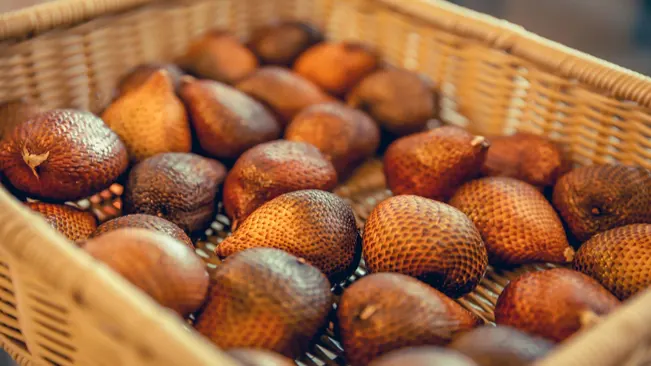
- Cleaning: Gently clean the fruits to remove any dirt or debris.
- Storage: Store the fruits in a cool, dry place. Snake Fruit has a relatively short shelf life, so it’s best consumed or processed soon after harvesting.
- Transportation: If transporting, pack the fruits carefully to prevent bruising. Use cushioning materials like straw or foam for protection.
Related Growing Guides:
Conclusion
Growing Snake Fruit can be a rewarding venture, both commercially and as a gardening hobby. Understanding the specific needs of Salacca zalacca and providing consistent care will yield healthy plants and delicious fruits. Remember, patience is key as it may take a few years before the first harvest, but the unique taste and texture of Snake Fruit make it well worth the effort.
FAQs (Frequently Asked Questions)
- What climate is best for growing Snake Fruit?
- Snake Fruit thrives in tropical and subtropical climates with high humidity and temperatures between 22°C to 30°C.
- Snake Fruit thrives in tropical and subtropical climates with high humidity and temperatures between 22°C to 30°C.
- How do I propagate Snake Fruit?
- It can be propagated either from seeds or suckers. Seeds should be cleaned and sown in well-draining soil, while suckers can be detached from the parent plant and replanted.
- It can be propagated either from seeds or suckers. Seeds should be cleaned and sown in well-draining soil, while suckers can be detached from the parent plant and replanted.
- How much space is needed between Snake Fruit plants?
- Ideally, plant Snake Fruit trees about 5 to 6 meters apart to ensure they have enough room to grow.
- Ideally, plant Snake Fruit trees about 5 to 6 meters apart to ensure they have enough room to grow.
- What type of soil is suitable for Snake Fruit?
- Fertile, well-drained soil with a slightly acidic to neutral pH is best. The plant does not tolerate waterlogged conditions.
- Fertile, well-drained soil with a slightly acidic to neutral pH is best. The plant does not tolerate waterlogged conditions.
- How often should I water Snake Fruit plants?
- Keep the soil consistently moist but not waterlogged. Overwatering can lead to root rot, so ensure good drainage.
- Keep the soil consistently moist but not waterlogged. Overwatering can lead to root rot, so ensure good drainage.
- What kind of fertilizer should I use?
- A balanced, slow-release fertilizer rich in potassium and nitrogen is recommended.
- A balanced, slow-release fertilizer rich in potassium and nitrogen is recommended.
- How do I prune a Snake Fruit tree?
- Carefully prune the spines and old fronds to facilitate harvest and maintenance, while wearing protective gloves to avoid injuries.
- Carefully prune the spines and old fronds to facilitate harvest and maintenance, while wearing protective gloves to avoid injuries.
- How do I protect Snake Fruit from pests and diseases?
- Regularly check for pests like mites and scale insects, and use appropriate organic or chemical treatments. Prevent fungal diseases by ensuring good air circulation and avoiding overwatering.
- Regularly check for pests like mites and scale insects, and use appropriate organic or chemical treatments. Prevent fungal diseases by ensuring good air circulation and avoiding overwatering.
- When is Snake Fruit ready to harvest?
- The fruit is ready when the skin turns a deep reddish-brown and the scales slightly open. Use gloves and a sharp tool to harvest the fruit clusters.
- The fruit is ready when the skin turns a deep reddish-brown and the scales slightly open. Use gloves and a sharp tool to harvest the fruit clusters.
- How long does it take for a Snake Fruit tree to bear fruit?
- It may take a few years for a Snake Fruit tree to begin bearing fruit, especially if grown from seed. Patience is key as the plant matures.

Emma Hudson
Forestry AuthorEmma's experience in farming shapes her detailed guides on gardening and farming tools, providing practical, actionable advice grounded in real-world experience. Her work targets both newcomers and experienced farmers, aiming to enhance their practices with a mix of traditional wisdom and modern techniques. By making complex agricultural concepts accessible, Emma's guides serve as valuable tools for those navigating the challenges of contemporary farming, offering strategies for sustainable success.





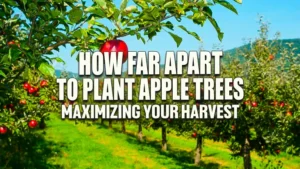



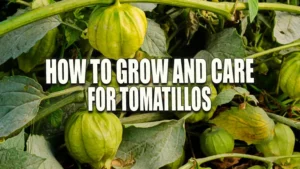



Leave your comment